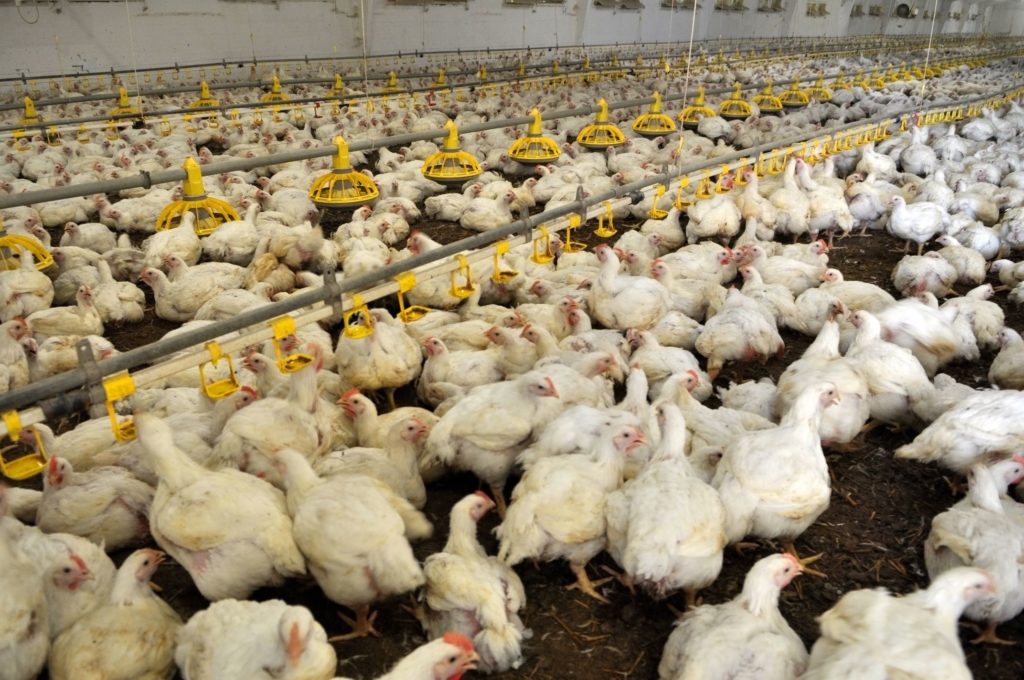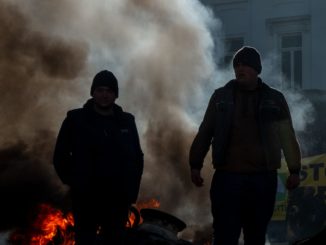
There is a perception that, when it comes to the farming end of the agri-food system, CAP is primarily about supporting land owners and family farms. Is this the case? And even if so, does the Commission sometimes use the basic underpinnings of CAP to gloss over what are in fact significant, embedded supports for the most intensive end of the farming systems, including livestock? What does this mean for other producers? We attended a webinar on livestock recently, and these questions came to the fore.
In February, a webinar organised by European Coordination of La via Campesina (ECVC) was held on EU-level measures for peasant models of Livestock farming. The webinar is in French, but the European Commission contributions are in English.
If you watch this webinar, something emerges: the gap between words and actions. While the Commission speaks solidarity with small scale livestock farmers at a surface level, and in particular with the current Commissioners tweets and statements, in reality, when we get into the details, things are, as usual, a little more complicated.
So in this article, inspired by our attendance at this webinar, we focus on myths vs realities. The myth we contest is that put forward in this webinar by the Commission – that CAP somehow doesn’t favour intensive farming* because the CAP primarily supports land owners. The underlying argument is that through per-hectare direct payments, CAP support extensification, not concentrated intensive farming.
CAP, Cash and the Commission – Overarching Considerations
The idea that CAP somehow doesn’t favour intensive farming because its all about land owners and by extension family farms is worth challenging on a number of fronts.
Firstly, the Commission DG AGRI should explain by which data it can claim intensive farming enterprises are also not large land owners at the same time, including via rented land.
Secondly, per-hectares direct payments are not the only EU instruments that could favor intensive farming – though they absorb a large volume of CAP budget. Other CAP interventions, import-export trade rules, public risk management subsidies, food and rural policies within and outside DG AGRI’s competences are deeply intertwined in intensive farming supports. (Have a look at this simple list of possibilities through which the CAP and other EU legislations can provide soft and hard support to intensive pork and poultry farming in particular, which we outline below.)
Thirdly, the solidarity expressed in words to peasant livestock farmers, but the lack of position and concrete answers in the webninar, shows an urgent needed shift in agricultural policy making by DG AGRI.
Why isn’t it DG AGRI that is boosting its networks and efforts to understand the conditions and problems specific to disappearing peasant livestock farming before they totally vanish, and urgently come up with a system change proposal.
The game is stacked towards the intensive, more industrialised end of the spectrum, in all its elements. Expecting poorly funded and peasant-organised civil society organisations like La Via Campesina to come forward with beautifully laid out strategies and in-person functionnaiers’ is either politically naïve, distractingly mendacious, or both. t
The playing field is not level, it is dominated by the professionalised lobby apparatus of COPA-COGECA’s and the wider agri-industrial support network: the rest are left with romanticised compassion without significant action by key decision-makers.
Cash for intensive livestock produce – storage and marketing
CAP allows for what it calls market support for some of the products of intensive farming, including pork and poultry, which are usually at the more industrial end of the spectrum. These include public intervention, private storage aid (PSA), withdrawals (money going without any environmental strings attached). We cover this development often, in 2015, in 2016, it happens for other sectors too of course, e.g. of milk in 2020) and more recently in 2022 – see below and the official text (PSA-pig-2022)
CAP Strategic Plans and Food Security: Fallow Lands, Feeds, and Transitioning the Livestock Industry
A concern here is that there are hardly ever any socio-ecological strings attached when these monies appear, while the data, accountability and reporting on these interventions remains hard to access or analyse critically at EU and Member State (MS) level.
There are few lessons learned or adjustments when risks become realities. Where is the transition towards fewer externalities, towards more sustainable ends? Europe’s agri model involves a lot of resource-intensive meat production, and it seems that the show must go on, as it were, whatever the context as regards supply of animal feed inputs, competition from human feed needs, or availability on markets.
The CAP budget share for this is tiny compared to the rest of CAP, while intensive producers often complain its too little too late. Yet these maneuvers can move substantial resources for a few beneficiaries with very few conditions.
CAP also encourages the marketing of intensively produced meat. Relatedly, the European Agriculture Guarantee Fund (the first Pillar of CAP) supports what are called market intervention measures, with promotional campaigns funded up to 80%. E200 was spent in 2020 million on these promotional campaign, which favour the bigger, more industrialised payers in each sector.
All of this is in a somewhat murky area, as regards WTO rules and the rules of national governments within the EU: for the latter in particular, there are concerns regarding what MS are allowed to do as promotional strategies in a context of the EU’s common market (see cpt. Five of the 2021 Marketing Meat report.)
Overall animal products are the most promoted products in these campaigns at 32%, or over E250 million in the 2016-2020 period. It is the case that not all meats are intensively produced – some comply with quality schemes, and some are produced by small-scale agroecological producers. However, as Marketing Meat shows, and this is key
“eligible organisations need to be “deemed representative” of at least 50 % of their sector, calculated by market share or the number of producers. This means it is more difficult for smaller organisations and producers to access the funding, and so harder for them to break into markets with new products that might challenge the existing, dominant players.”
So while there is a spectrum of meat from the La Via Campesina vision to the biggest of intensive, industrialised units, CAP prioritises the most powerful, most organised players.
In reality then, the idea that CAP doesn’t support intensive livestock farming isn’t borne out by the facts – especially when it comes to storage interventions or marketing.
Other supports
CAP Pillar II investments for farm modernisation TAMS – allows for capital investments, but one style gets extra supports above all others – intensive pork and poultry units: in the example cited here (Ireland February 2023) the investment ceiling is E90,000 for all 10 sectors except pig and poultry, where it is E500,000.
There are also coupled supports for farmers to grow animal feeds and a range of other soft, or indirect supports. These include free trade agreements with non-EU countries exporting feed for intensive livestock; derogations and low enforcement of environmental regulations; liberalisation of state-aid rules, and poor enforcement of labour, animal welfare and pollution laws more generally.
These soft supports don’t all necessarily favour intensive livestock, or even exclusively -this is how our economy operates. However they do favour whoever the biggest and most established of players are, while they hinder opportunities for both small players and for transition towards more agroecological approaches.
And, just to be clear, we are not making claims about any specific producers specific intensive pork or poultry producers, or livestock farmers. Many strive for higher standards, constrained as they are by market realities and institutional/political structures. Indeed, it is also the case that small scale producers can flout various laws – they are not immune from these pressures either.
But what we are also saying is that poor enforcement of these laws can disadvantage producers and approaches trying to keep to these rules and regulations, and possibly even operate to higher standards. This in itself certainly makes the ECVC vision of a more sustainable approach to livestock, or the visions of organic or regenerative approaches, more difficult to achieve.
Moreover, this simply adds to the basic point made here – there are a range of hard and soft, direct and indirect supports stemming from EU policies and approaches – and CAP in particular – for intensive meat production – whatever about the oft repeated refrain that CAP is all about supporting land owners.
To claim otherwise, and presume it is an accepted part of the discourse, because of a pre-conception around these land-based supports in CAP as the main cornerstone of how CAP works, is under-informed.
Not just pork and poultry
It is also worth remembering that supports, subtle and overt, are in place for the more intensive end of other meats and for dairy. These include coupled supports, nitrate directive exemptions, poor eligibility criteria in redistributive payments, lack of effective capping, weak conditionalities, and oft granted derogations. Indeed, intensive horticulture gets a range of supports too, including regarding the size of supported producer organisations, derogations for banned pesticides and other biocides and so on.
Much of this is outlined in our CAP work, a recent summary example is here:
The effective stalling of the first significant piece of the Green Deal agri-food legislation – the SUR on pesticides – tells us all we need to know about the balance of power in this sector, including in the EU institutions. It is unlikely that the SUR will complete its path towards implementation, before European Parliamentary elections in 2024.
This Green Deal, announced as a man on the moon moment in December 2019, and it will fall at the first real farming hurdle due to the stalling mechanisms of centre-right and other politicians in the Parliament and member states. The man has been left on the moon to fend for himself.
To Conclude
It is worth repeating – why is it ECVC making these points to the Commission? The Commission and the EU institutions more generally are the ones with the comparably enormous resources and staffing, whereas ECVC is largely made up of volunteers. Further, there is an enormous lobby feeding information into the EU institutions, which, again, ECVC and others having nothing like.
This money needs to be rebalanced in the Commission’s mindset for societal needs, which simply cannot translate into lobby power for good.
Perhaps it is time for the Commission leave the script behind, and to get their feet onto the ground more often. Perhaps it is time for them to visit agroecological farms, or communities impacted by agricultural pollution, to discover more of the realities people experience and face. This could help inform the top down processes – be they CAP or Farm to Fork.
There is much to learn from seeing what’s working in broader terms – social, environmental and economic – what’s avoiding externalities, and adjusting legislation to help these more agroecological and peasant approaches to livestock blossom.
Intensive farming explainer
*Intensive farming can be defined in many ways, and, in this article we will not spend an excessive amount of time defining it. Political economists, geographers and rural sociologists tend to work from the foundation of Goodman, Sorj, and Wilkinson (1987) or similar political economics of the era, with the idea of appropriationism and substitutionism of previously more nature connected practices. The full width of this spectrum is from a notion of pure nature to a notion of pure industry, with acts like the invention of the plough, of the tractor, of fertilizers, of confined indoor animal units, of GMOs, and so on, steps along the way await from nature and towards industrial society. This is because ever more of the inputs and methods/processes involved in farming, or, more recently, agri-food, are from closer to the socio-industrial end of the spectrum.
This means in the case of livestock, in particular pigs or chickens, much or even all of its life may be managed for profit accumulation at this socio-industrial end of the spectrum. This means indoors, with little access to the outside (nature), with feed produced using biocides, mineral fertilizers, routinely medicated and so on (for more).
More broadly, we may also consider a high use of external farm inputs but a narrowing selection of breeds or varieties; loss of farmer power and control to companies, organizations, regulations and more, further up, down (the vertically integrated ) or across (horizontally integrated) the food system, depending on the commodity regime.
This results in farmers’ subordination (debt, price-taking, loss in overall numbers) within restrictive capitalist structures (ever more onerous contracts, etc)
Though intensive farming might claim greener performances through the use of modern technologies for reducing specific negative externalities (methane emissions, carbon efficiency per kilo), this production paradigm fails to holistically integrate more sustainable contributions to biodiversity, food quality, social justice, production autonomy, local food resilience, or animal welfare.
Movements such as the organic farming movement are an example of the pendulum swinging somewhat back towards nature and away from industry, though it too goes through swings as it grows in scale. In other words, processes of capital accumulation continue as commodification or conventionalisation more broadly impact these alternatives; nevertheless, new and renewed agri-food movements emerge top challenge this power dynamic.
France | Pesticides, PDOs & Plenty of Spin at Salon de l’Agriculture 2023
Ireland | Intensive Farms Must Pull their Weight for a Just Transition
The True Cost of Britain’s Addiction to Factory-Farmed Chicken
Time for US and EU to Regulate Factory Farms’ Greenhouse Gas Emissions
Ammonia Pollution | The role of CAP and Northern Ireland’s State Funders
The Netherlands | Are Agri-Food Workers Only Exploited in Southern Europe?
Covid19, Meat Processing Plants and the Limits of the Intensive Farming Model





